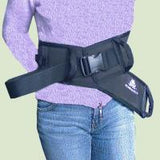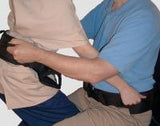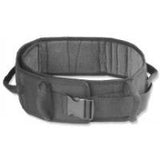Take a closer look
The SafetySure® Transfer Belt has features that no other transfer belt offers. Numerous hand grips provide the caregiver a variety of leverage points. The anti-slip interior prevents the belt from moving during the transfer process. And, the easy-to-fasten "fix lock" buckle allows the caregiver to tighten the transfer belt once the individual is in a standing position, without having to open the belt. The SafetySure transfer belt is available in four sizes - small, medium,large, and extra large. The extra large belt is designed to be use with bariatric patients.
For safer transfers, it is recommended that both patient and the caregiver wear a transfer belt. This helps lower patient anxiety and reduces backstrain on the caregiver.
The SafetySure® Transfer Belt is used to:
- Help a patient stand or sit
- Help an individual rise from the floor
- Patient transfers from bed, wheelchair, toilet or car
- Provide support while walking
- Protect patients who are unstable when standing
- Help patients maneuver when using the bathroom
- Reduce the risk of back injury to patient and staff during patient transfers
Transfer Belt Specifications
| Specification | 6033 | 6034 | 6035 | |
| Width | 4" | 4" | 4" | |
| Length | 36" | 48" | 60" | |
| Thickness | 3/8" | 3/8" | 3/8" | |
| Fits Waist | 23" - 36" | 32" - 48" | 42" - 60" | |
| Number of Hand Grips | 5 | 5 | 7 | |
| Weight Capacity | 300 lbs. | 300lbs. | 300lbs. |
WARNING:California's Proposition 65
SKU: 6033, 6034, 6035 Transfer Belt, Transfer Belts, Gait Belt, Gait Belts
Positioning the Transfer Belt
Position the transfer belt low on the individual's waist. Tighten the belt by pulling on the two end pieces (fig. 1). Keep in mind that a person's girth is greater when sitting. It is important that the transfer belt be comfortable but tight. To remove the transfer belt, release clips on both sides of buckle.

Use of Transfer Belt to Help A Patient Sit or Stand
There are many ways to use the transfer belt to help a patient sit or stand. Think of the direction of the transfer and follow the body's natural pattern of movement (fig. 2 - 6). The patient, the caregiver, or both can wear a transfer belt.
.gif)
Helping A Patient Up from the Floor with A Transfer Belt
The Transfer Belt is extremely useful in helping someone up from the floor. Remember, do not lift straight upward, but follow natural motion. The patient can gain more support by leaning against a bed or holding onto a chair (fig. 7).

Transfer Between Bed and Wheelchair with a Transfer Belt
A transfer belt is a big help in patient transfers from bed to wheelchair. The patient can be either standing or sitting (fig. 8).
Transfer Between a Wheelchair and a Car with a Transfer Belt
For patient transfers into a car, SafetySure™ Transfer Board can be used in combination with a transfer board (fig. 9). Take care so the patient doesn't wind up sitting between the wheelchair and seat of the car. With a passive patient, SafetySure™ Transfer Sling (Item 3011) may also be used. Place it underneath the buttock area of the patient. Using this technique makes the transfer easier for both patient and the caregiver.

Using a Transfer Belt for Aid During Toileting
For toileting, it is important to plan ahead and keep the safety of both the patient and caregiver in mind (fig. 10). If there is not enough space in the bathroom, it is best to use a commode somewhere outside the bathroom. If the patient is heavy, two assistants may be necessary (fig. 11).

Transfer Belt Usage for Support When Walking
When supporting someone who is ambulatory, it is important to keep on arm around the patient for protection (fig. 12). Always hold the individual close to you. This enables the caregiver to react more quickly if the individual needs help and reduces the amount of strain on the caregiver. The Transfer Belt, with its multiple handles, provides good grips and a comfortable way of supporting the individual.

Protecting an Ambulatory Patient with Balance Problems
When there is a risk that an individual could fall while walking, it is important to hold the individual close to the caregiver in order to prevent the patient from slipping down. If this does occur, let the individual slide down along the outside of the caregiver's leg (fig. 13).
Transfer Belt Directions for Use
Please read the instruction sheet before using the Safety Sure Transfer Belt. If you have questions concerning the use, please call us - MMP Medical Supply - on our toll free number 1-800-854-4687.






